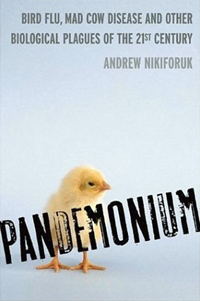
- Pandemonium
- Viking Canada (2004)
- Bookstore Finder
Andrew Nikiforuk's Pandemonium: Bird Flu, Mad Cow Disease and Other Biological Plagues of the 21st Century is an annoying but important book.
The veteran Calgary journalist describes the increasingly nasty diseases -- avian flu, MRSA (methicillin-resistant Staph aureus), and mad cow disease -- that find increasingly rapid ways to spread. He also describes the animals, from zebra mussels to bullfrogs to farmed salmon, whose equally rapid spread has disrupted ecosystems around the planet. We are both vectors and victims of these plagues.
Although Pandemonium employs an irritatingly chatty style (Nikiforuk tells us, for example, that H5N1 "flattened a flamingo," "gobbled up birds and people" and "continues its quest for global citizenship," "hitching a ride on untreated poultry manure, smuggled birds, and poultry trucks"), it's still a very good survey of the ecological chaos we've provoked. These are plagues we have inflicted on ourselves, the direct result of accelerating global trade, travel and migration. We tend to notice them when they pop up in the media, and then to forget them as soon as the media turn elsewhere.
Nikiforuk hasn't forgotten. When he talks about livestock plagues like the spongiform encephalopathies, he goes back to rinderpest and the social and ecological devastation the cattle virus caused in Africa a century ago. When he discusses the threat of today's plant diseases, it's in the context of Ireland's potato famine and the wheat rusts of ancient Rome.
The concise historical summaries of earlier plagues and blights make it clear that we now face similar problems -- but with far higher stakes and far fewer alternative resources.
"Corn used to come in 50,000 varieties suited for different locales and for resistance to particular pests," Nikiforuk says, "but agribusiness prefers just six types. Wheat, which once boasted 30,000 varieties, now comes in only three or four varieties… The mighty field of 5,000 potato varieties has largely been reduced to the Burbank, an obese tuber suited to making french fries…"
Is Alzheimer's really mad cow disease?
Monoculture enables us to feed billions relatively cheaply, but it also exposes us to attacks of ever-evolving pests. Nikiforuk emphasizes the tempting economic attractions of monoculture and the catastrophic economic consequences: the migration of H5N1 into poultry factories and then into humans; the casual transfer of dangerous pests in freighters' ballast water and in the wood of packing crates; the costs saved by turning cattle into cannibals, and the high price of BSE.
Nikiforuk even speculates that senile dementias like Alzheimer's disease might be unrecognized forms of mad cow disease.
Though he doesn't set out a fully developed argument that globalization is the villain, Nikiforuk repeatedly cites the ships and planes of global trade as the true vectors of each of these new diseases.
The economic activity that fuels this trade is also the agent of global warming, opening up new territory for pests and ecological invaders. The mountain pine beetle is only one such opportunist. West Nile virus first appeared in North America in New York in 1999. It has already occupied the entire U.S. and many Canadian provinces. B.C. has so far escaped, but not for long.
Against this onslaught, our medical resources are worse than pathetic -- they're traitors, allies of the plagues themselves. "Nosocomial" outbreaks, epidemics in hospitals, have become routine thanks to inadequate cleaning, misuse of antibiotics and health workers' own appalling disregard for basic hygiene. Public health programs have been systematically strangled for ideological reasons disguised as "cutting the fat out of the system." Nikiforuk makes it clear that infections like MRSA are our own fault.
Pandemic in plain English
Nikiforuk is writing a popular book on unpopular subjects. To understand them, we need some technical background.
But Nikiforuk's needlessly chatty style dumbs down much of his argument. Consider this description of the Colorado potato beetle: "...a minor plant munch until a human invasion plowed up the local greenery and replaced it with a monoculture of Peruvian interlopers: the potato. The beetle couldn't believe its good fortune and tucked in like a Las Vegas gambler at a free buffet. It now dines on most of the world's global potato plots."
This is not an occasional lapse, but a deliberate strategy. Presumably this overwrought language is supposed to entertain us and get us through the scary and technical parts. Instead it merely draws attention to itself and away from its subject.
When he has completed his survey, however, Nikiforuk suddenly drops his chatty style to give us an epilogue, in straightforward English, foretelling an avian-flu pandemic: "...with a 2.5 per cent death rate will shock the economy and turn the health-care system upside down. It will infect more than 100 million people in North America and kill at least two million. Such an event will rapidly erase North America's mirage of security.
"With more than a third of the workforce sick, or caring for the sick, vital public services will suffer or collapse. Water treatment technicians will be too sick to purify urban water supplies, while garbage collectors will be too listless to pick up the trash. A shortage of electrical workers could trigger a series of power outages in a decrepit system already prone to blackouts. Other invaders, from rats to flies, will seize the day to feed on growing mountains of human waste -- and the dead."
Andrew Nikiforuk brings together a range of problems that we have tended to regard as just one damn thing after another. Instead he shows that they are all the same damn thing, flourishing as never before because of human greed and political apathy. Whether the next catastrophe is H5N1 or famine or something not yet imagined, we victims will have no one to blame for it but ourselves.
Crawford Kilian follows the spread of avian flu at H5N1.
Related links and Tyee stories: For other reviews of Pandemonium click here. For chapter one of Pandemonium click here. For The Tyee's "Wild Claims about Avian Flu" click here. For Crawford Kilain's "Blogging the Pandemic" click here. For Eve Johnson's "The Ducks in the Henhouse" click here. For The Tyee's "Mad Cow USA" click here. For "Life After Cannibal Cows" click here. ![]()




